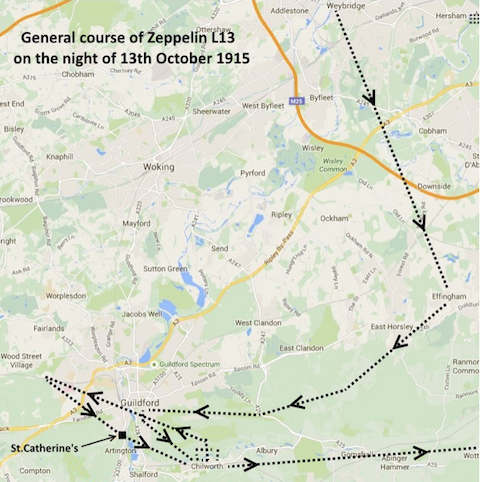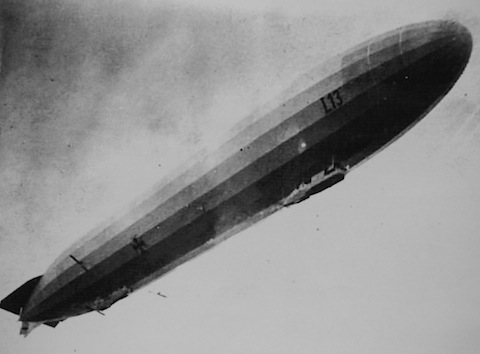 Abraham Lincoln
If given the truth, the people can be depended upon to meet any national crisis...
Abraham Lincoln
If given the truth, the people can be depended upon to meet any national crisis...
 Guildford news...
for Guildford people, brought to you by Guildford reporters - Guildford's own news service
Guildford news...
for Guildford people, brought to you by Guildford reporters - Guildford's own news service
Letter: Further Thoughts On The L13 Zeppelin Raid in 1915
Published on: 15 Oct, 2015
Updated on: 15 Oct, 2015
By Frank Phillipson
Here, Frank offers a number of comments about the infamous Zeppelin raid of October 13, 1915, that resulted in 12 bombs being dropped on and near St Catherine’s Guildford, and the subject of the story published in The Guildford Dragon NEWS on the 100th anniversary of the event.
His research has, and continues to be, most valuable to this important night in Guildford’s recent history.
The commander of the L13 Zeppelin, Heinrich Mathy, was in charge of the whole raid. This experienced and heroic commander and his crew dropped bombs over the site of an anti-aircraft gun near Hatfield in Hertfordshire and then picked up the Thames on their way to attempt to bomb the waterworks at Hampton.
I’m not sure there is any evidence that Mathy was planning to bomb Hampton waterworks other than that he claimed to have bombed it. It is possible that it was on a list of potential targets.
British intelligence picked up a radio report from L13 (“UL”) “Bombed Hampton waterworks at 11.30” (this is probably German time, it being 10.30pm British time).
It appears that while over Weybridge Mathy “missed a vital bend in the Thames and headed down the River Wey instead, passing places such as Newark and Send”.
By Weybridge, if travelling westwards, he’d already passed Hampton waterworks.
I’m not sure that he missed a vital bend in the Thames. That theory was expounded in one of the books on the subject. At Weybridge the River Thames heads north towards Staines. The River Wey heads southwards towards Pyrford.
According to Ernest Yates it was a clear moonlit night so an experience naval officer should probably have been able to navigate via the stars. He would at least have been able to determine his direction even if his compass was not working for whatever reason.
The Aldershot Command report of the raid states that the Zeppelin was seen from the powder works (Chilworth) at 10.05pm steering a course along the ridge of hills (the North Downs).
The general timing of sightings of Zeppelin L13 was as follows:-
9.50pm: Weybridge.
9:55pm: Effingham (not on the River Wey).
10pm: Clandon and Gomshall (seen from either side of the downs).
10.05pm: Newlands Corner.
10.10pm: Guildford.
10.15pm: Chilworth Gunpowder Factory, anti-aircraft gun starts firing, L13 veers off westward but circles back round but then goes off westwards and is over Guildford at….
10.20pm: L13 carries on to Wood Street then turns south-east over the Hog’s Back to St Catherine’s.
10.25pm to 10.30pm: bombs dropped on St Catherine’s.
10.35pm to 10.40pm: L13 flies over Gun Powder factory again and goes off in the direction of Dorking.
 With regard to the target, Hampton waterworks are situated on the Thames where it runs east-west and is on the flat ground of the Thames flood plain. Guildford and Chilworth are located by the North Downs. The only possible river big enough to be observed from above in the Guildford vicinity is the River Wey running north-south.
With regard to the target, Hampton waterworks are situated on the Thames where it runs east-west and is on the flat ground of the Thames flood plain. Guildford and Chilworth are located by the North Downs. The only possible river big enough to be observed from above in the Guildford vicinity is the River Wey running north-south.
My best guess as to why “St Catherine’s” was bombed is that Mathy intended to aim for the anti-aircraft gun that had fired at him at the powder works but misjudged its position. It might be that he mistook “The Mount” for “St Martha’s” given that they are of a similar sort of height and profile. The argument that the chapel at “St Catherine’s” was mistaken for “St Martha’s” doesn’t really stack up with the former being located on a very much lower and less distinguishing location.
The crew of L15 captured in 1916 when interrogated (report of May 28, 1916) said that the Zeppelins flew as high as possible over land (at around 10,000ft). On a clear night it was not difficult to recognise the coastline. Sometimes it was possible to see rivers but usually not. On the night of the October 13/14 1915 they said that there had been lots of light showing on the ground but by March 1916 most lighting was dimmed.
They also stated that it was impossible to distinguish particular localities in towns or individual buildings at night and so all “bomb throwing” was more or less haphazard. All bomb aiming was carried out by officers with the bombs dropped by a lever from the central gangway (inside the main body of the airship) through a sliding door.
Responses to Letter: Further Thoughts On The L13 Zeppelin Raid in 1915
Leave a Comment Cancel reply
Please see our comments policy. All comments are moderated and may take time to appear. Full names, or at least initial and surname, must be given.Recent Articles
- Highways Bulletin May 19 – Protecting Wildlife During Roadworks
- Letter: It Would Be Good to Have Wind Turbines on the North and South Downs
- Letter: CIL Victims Deserve an Apology and Their Money Back
- 30 Objections Received on South Guildford Garden Infill Proposal
- Ash Residents Come Together To Counter Catapult Attacks On Canal Wildlife
- Notice: Guildford Homestay
- Letter: Cowardly Attacks on Wildlife Have Got To Be Stopped
- Angry CIL ‘Debtors’ Thanked for Their Patience by Waverley Council
- Letter: If the Shalford Councillor Wants Wind Turbines Put Them in Shalford
- Birdwatcher’s Diary No.327


Recent Comments
- R Wong on Angry CIL ‘Debtors’ Thanked for Their Patience by Waverley Council
- Paul Robinson on Ash Residents Come Together To Counter Catapult Attacks On Canal Wildlife
- J Crawford on Angry CIL ‘Debtors’ Thanked for Their Patience by Waverley Council
- Brian Quinn on Angry CIL ‘Debtors’ Thanked for Their Patience by Waverley Council
- Rainee Wornham on This Year’s Guildford Fireworks Night By the Lions Could Be the Last
- Susan Smith on Birdwatcher’s Diary No.327
Search in Site
Media Gallery
Dragon Interview: Local Artist Leaves Her Mark At One of England’s Most Historic Buildings
January 21, 2023 / No Comment / Read MoreDragon Interview: Lib Dem Planning Chair: ‘Current Policy Doesn’t Work for Local People’
January 19, 2023 / No Comment / Read MoreA3 Tunnel in Guildford ‘Necessary’ for New Homes, Says Guildford’s MP
January 10, 2023 / No Comment / Read More‘Madness’ for London Road Scheme to Go Ahead Against ‘Huge Opposition’, Says SCC Leader
January 6, 2023 / No Comment / Read MoreCouncillor’s Son Starts Campaign for More Consultation on North Street Plan
December 30, 2022 / No Comment / Read MoreCounty Council Climbs Down Over London Road Works – Further ‘Engagement’ Period Announced
December 14, 2022 / No Comment / Read MoreDragon Interview: GBC Reaction to the Government’s Expected Decision to Relax Housing Targets
December 7, 2022 / No Comment / Read MoreHow Can Our Town Centre Businesses Recover? Watch the Shop Front Debate
May 18, 2020 / No Comment / Read More












Ian Castle
October 15, 2015 at 10:42 am
Ernest Yates’ comment that it was a clear moonlit night might be a little misleading.
It was a clear night but the new moon appeared on 8th October and was approaching the first quarter on the night of 13/14th October.
But it is clear when reading the reports of Zeppelin commanders that Mathy would not have known he was bombing Guildford – later the same night he reported bombing the Woolwich Arsenal but was in fact on the other side of the Thames, and his bombs struck the Royal Victoria Dock.
All interesting stuff though.
David Wragg
October 15, 2015 at 7:15 pm
Positioned under the huge envelope of the Zeppelin, the crew would not have had a good vied of the stars.
And although some of these craft had a tunnel running from the gondola to the top, this was hardly helpful for precise navigation.
Being lighter than air, one also has to take into account that wind would have had an even greater effect on Zeppelin control and navigation than with an aeroplane.
The fact that the crew were banned from using parachutes is not unusual. British aircrew with the Royal Flying Corps and Royal Naval Air Service were also forbidden parachutes on the grounds that it would encourage them to bale out.
In fact, WWII experience showed that aircrew with parachutes were more likely to try and save their aircraft.